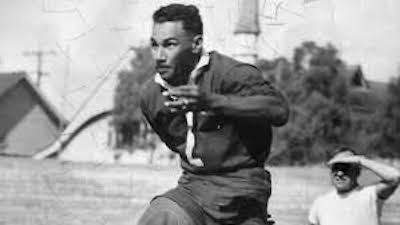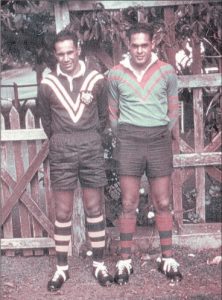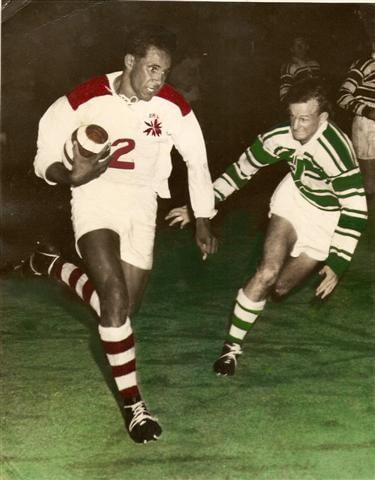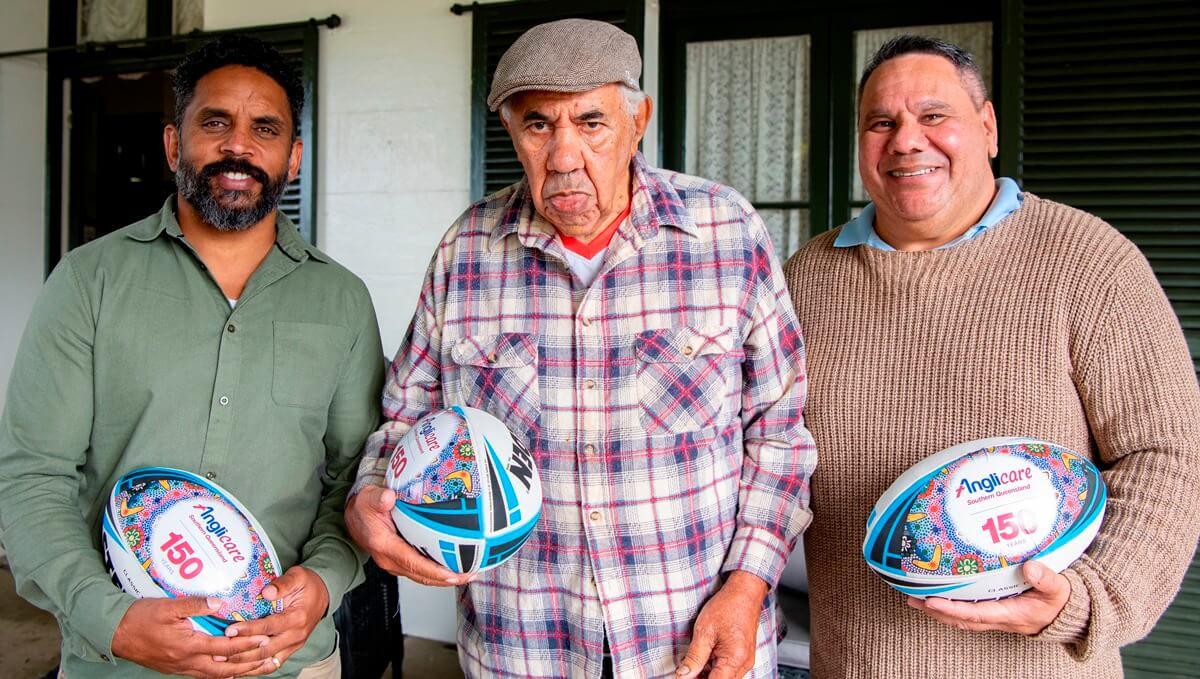Lionel Morgan
Footy, family, community: the pillars of Lionel Morgan’s life have never changed.
Lionel Morgan: The Man, The Story, The Legend.
Click the play button above to watch the short film.
Written by Leanne Edmistone – printed in the QWeekend 8 August 2020.
Sixty years after he became the first Aboriginal player to be selected in a national team and play for his country, Lionel’s memories are being relentlessly cruelled by dementia.
Still, there’s nothing the Indigenous Team of the Century winger likes better than reminiscing, whether on the men’s bus trips organised by Anglicare Southern Queensland’s E.M. Tooth Residential Aged Care Home, Wynnum, where he lives or with family over his favourite Eggs Benedict breakfast at Tide on the Jetty, looking out across the harbour waters he once plied for a living.
On the anniversary of his test debut at the Brisbane Exhibition Grounds and eve of Lionel’s 82nd birthday [August 12], the legacy of a player and coach widely recognised as a true gentleman of the sport is being celebrated.

Photo: Lionel Morgan
Messages for a legend
Gorden Tallis
“Living up in northern Queensland, your name was so famous, it was up in lights.”
Gorden Tallis is one of Queensland rugby league’s toughest and most inspirational products. Gorden Tallis was born in Townsville and joined the Brisbane Broncos in 1997, after a 4 year stint with St. George. He was labelled the “raging bull” because of his fearless, no-holds-barred style of forward play. He played eight seasons for the Broncos, winning three premierships. He has captained the Broncos, Queensland State of Origin, and the Australian Kangaroos side.


Mal Meninga
“… the work you used to do with all the Indigenous kids you’ve mentored over the years, you must be very happy with what you’ve done in life.”
Mal Meninga OAM is an Australian professional rugby league football coach currently in charge of the Queensland State of Origin team. His career as a player spanned over 15 seasons and he is known for his legendary goal-kicking ability. Rugby League Hall of Fame inductee Mal Meninga is best known by Australians for his formidable power, pace, handling, deadly accuracy and consistency with the boot.
Ryan James
“Being the first Indigenous player to represent Australia is no small feat.”
Growing up in Tweed Heads, northern New South Wales, Ryan James represented the NSW CHS under 15s schoolboy team in 2006. James made his NRL debut in 2010 for the Gold Coast Titans as a prop and second-row forward. He played for the Indigenous All Stars and Country Origin sides. James currently has a contract with the Titans until the end of 2020.


Wally Lewis
“… playing for Queensland and Australia, achieving something in success that very few people were lucky enough or good enough to achieve.”
Wally Lewis came to embody State of Origin football. A young lock forward in the inaugural Origin game in 1980, he made 30 appearances as five-eighth and captain between 1981 and 1991, winning eight man-of-the match awards. Lewis made his Test debut in 1981, against France, the only Queensland-based player in the side.
Cody Walker
“You’ve paved the way for a lot of young Indigenous players … I’ve heard so many stories about your talent and speed.”
Cody Walker played for the Gold Coast Titans NYC earlier in his career. Walker went on to play with the Queensland Residents in 2013, winning the Queensland Cup’s Best and Fairest award as well as topping the competition for points scored. Walker made his NRL debut in 2016 for the Rabbitohs against the Sydney Roosters, at five-eighth. He became part of the representative scene in 2019 having played for New South Wales and the Australian Prime Minister’s XIII, as well as captaining the Indigenous All Stars team.


Steve Renouf
“Such a beautiful man. A real gentleman to the game and an all-round good bloke.”
Steve Renouf is a Gunggari and Gubbi Gubbi man. He holds the record for most tries for the Broncos (142), and was named in the Broncos 10 and 20 year teams, the 25 year grand final team, and the Indigenous Team of the Century. He played 212 Broncos games, 11 Queensland State of Origin games, 9 International Australian Rugby League Tests, and was part of 4 premiership winning teams for the Broncos.
E.M. Tooth Residential Aged Care Home
Lionel lives in our Edwin Marsden Tooth Memorial Residential Aged Care Home (E.M. Tooth), near the esplanade and bay shores of Manly. Lionel and his fellow residents are supported by our qualified and caring staff, who create a community and friendships through activities and a variety of social hubs. On any given day, Lionel can be found catching sea breezes in the shaded al fresco area while meeting family and friends, or relaxing in the common lounge rooms where he loves to watch NRL games with his son, Earl.
The landscaped grounds include the heritage listed Georgian-style Lota House. Home to 101 residents, E.M. Tooth has recently been modernised and extended, creating a more family-orientated experience for residents and visitors. E.M Tooth is also home to 24 residents in the memory support unit, Wisteria Gardens. A garden, walking track and covered patio areas are all part of this peaceful setting. Montessori and other self-directed activities are encouraged so memory support residents can do the things they enjoy, such as baking or gardening.
Modern, bungalow-style, independent living units, known as Lota Court, are also nestled on the hillside of the property.
At E.M. Tooth we go to great lengths to make residents like Lionel feel at home and know their life experience and accomplishments are valued and respected.
Learn more about E.M. Tooth









